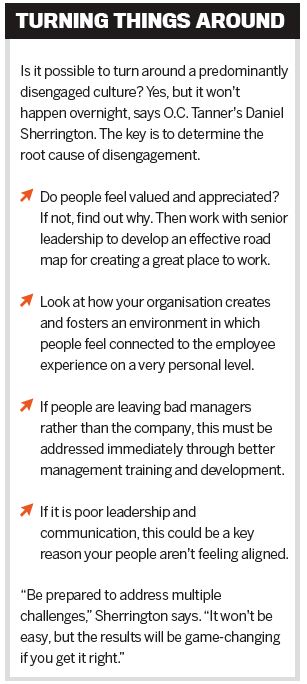
There is no instant fix for a disengaged workforce, but there are foundational steps employers can take to improve the situation

There is no instant fix for a disengaged workforce, but there are foundational steps employers can take to improve the situation. As part of a four-part series on employee engagement, HRD speaks with O.C. Tanner to find the best way to navigate the issue in Singapore.
Singapore continues to have the least engaged workers in the region, sitting at 59% according to Aon’s latest figures. Conversely, employers from neighbouring countries have seen improvements in engagement levels. Malaysian employers have seen an overall engagement score of 63%, while Indonesian employers sit at 76%. The Philippines (71%) and Thailand (64%) also outstrip Singapore.
What’s going wrong?
Daniel Sherrington, regional director APAC at O.C. Tanner, says country engagement scores are simply an indicator of what’s happening within the companies of a given country, so the real question should be: why are there so many low-engagement companies?
To answer the question, it pays to take a closer look at traditional management styles and how businesses are run.
For decades, Sherrington says, the prevailing management philosophy in Singapore – and much of Asia – has been grounded in managing for compliance rather than managing for new value creation. Low-engagement companies have approached work by defining tasks to be done and then holding people accountable for delivering only on what is expected.
The overarching management style in Singapore has tended to focus heavily on making sure employees are meeting expectations, and annual performance reviews are often similarly expectation-oriented. O.C. Tanner’s research indicates that Singapore is also quite unique due to a combination of key factors. Sherrington outlines these below.
Sherrington says millennials in particular don’t like work environments where these types of practices are common, because they feel underutilised and underappreciated. They ultimately reduce their levels of engagement and care less about their work and their customers.
“These companies get significantly fewer improvement ideas per employee, lower productivity, lower customer NPS, lower growth, and lower profitability,” he says. “Then company leaders complain that they don’t have enough money to invest in their people. And the cycle continues.”
Why it matters
Statistics from Gallup indicate that only 15% of the global workforce is engaged, so clearly work still gets done regardless of whether employees are engaged or not. However, how much more productive could the workforce be if it were engaged?
David Sturt, executive vice president of the O.C. Tanner Institute, says: “Many of the companies we work with, and ones we have studied that have a strong employee engagement culture, are achieving two to three times higher engagement levels, usually in the 70–80% range. As a result, they significantly outperform their competitors. They achieve much higher levels of innovation, productivity per employee, profitability, market share, and growth. They invest in engaging their employees, and the results speak for themselves.”
It must be stated that they also attract the best talent because everyone wants to work for these companies.

What can be done about Singapore’s poor engagement levels? There is no one silver bullet, but there are some key areas that must be addressed to ensure employees feel their work and presence truly matters, as Sherrington explains:
• Employee experience. “Companies that do this well focus on the entire employee experience, from hire to retire. This requires analysing all employee touchpoints, from the initial contact through the recruitment and onboarding process, to how they are rewarded and recognised, all the way through to their last day in the office. Employees must feel appreciated and valued at every stage of their career. At a foundational level you have to look at the big picture and not just try to fix the results of a bad employee opinion survey.”
• A sense of purpose. “Employees don’t just want a pay cheque – they want to feel like they are making a di‑ erence. The best hospitals help their janitorial sta‑ feel like part of the healing team. Great airlines empower sta‑ to make air travel a delight. If your employees don’t align with your organisation’s purpose, or have a direct line of sight to how their work contributes to that purpose, they can’t possibly achieve results.”
• Wellness in and out of the office. “I recently spoke to a lady at my animal welfare volunteering group in Singapore; she is a graphic designer and has worked for a Singaporean company for eight years and is highly regarded. She wants to leave because her employer is strictly against any staff working from home. This total lack of trust, despite having given eight years and many long hours to this business, has her wanting to leave as she feels underappreciated and undervalued, not due to the quality of her work being overlooked, but because she knows great companies provide flexible working arrangements, and she has more than earnt hers.
“With the millennials being more vocal, the trend for employees seeking work-life balance, flexible work arrangements, and improving wellness outside of the office is here to stay and likely to increase. Employees now demand that employers think about the overall wellbeing of their workforce, not just from nine to five. Whether it’s better leave benefits, programs to manage stress, or simply creating a culture that cares about employees’ physical, emotional, financial and spiritual health, companies must have a strategy to show employees they care, and it has to be consistent.”
• Opportunity. “Employees need to sense there’s an opportunity to grow and advance in their organisations. But growth doesn’t always need to mean a promotion. In fact, sometimes doing work you’re proud of provides an even greater high. There is a huge opportunity here to help employees develop and gain new skills, try new things, and innovate in ways that help your company grow. So let them.”
• Organisational agility. “Organisational agility means creating a company culture where employees adjust and adapt easily to constant changes in your workplace and industry. One thing is clear: employees want to work for a successful organisation, and successful organisations are not afraid of change. This may pose a challenge to risk-averse organisations that don’t like change. However, it is a very clear message from employees that they will better thrive in an agile environment.”
A strategic imperative
Most critically, Sherrington urges employers to treat employee engagement as a strategic business objective and not a ‘tick-the-box HR initiative’. He suggests not just talking to industry experts but also comparing internal sentiment figures with global and Singaporebased benchmark engagement figures published by the likes of Aon and Gallup.
“Ask yourself and your leaders if you really believe that you do a great job recognising and appreciating the good and great work being delivered in your organisation day in and day out, and look at what other businesses are doing as a best practice,” he says.